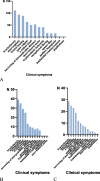Review of published 467 achondroplasia patients: clinical and mutational spectrum
- PMID: 38281003
- PMCID: PMC10822181
- DOI: 10.1186/s13023-024-03031-1
Review of published 467 achondroplasia patients: clinical and mutational spectrum
Abstract
Aim: Achondroplasia is the most common of the skeletal dysplasias that cause fatal and disabling growth and developmental disorders in children, and is caused by a mutation in the fibroblast growth factor receptor, type 3 gene(FGFR3). This study aims to analyse the clinical characteristics and gene mutations of ACH to accurately determine whether a patient has ACH and to raise public awareness of the disease.
Methods: The database of Pubmed, Cochrane Library, Wanfang and CNKI were searched with terms of "Achondroplasias" or "Skeleton-Skin-Brain Syndrome" or "Skeleton Skin Brain Syndrome" or "ACH" and "Receptor, Fibroblast Growth Factor, Type 3" or "FGFR3".
Results: Finally, four hundred and sixty-seven patients with different FGFR3 mutations were enrolled. Of the 138 patients with available gender information, 55(55/138, 40%) were female and 83(83/138, 60%) were male. Among the patients with available family history, 47(47/385, 12%) had a family history and 338(338/385, 88%) patients were sporadic. The age of the patients ranged from newborn babies to 36 years old. The mean age of their fathers was 37 ± 7 years (range 31-53 years). Patients came from 12 countries and 2 continents, with the majority being Asian (383/432, 89%), followed by European (49/432, 11%). Short stature with shortened arms and legs was found in 112(112/112) patients, the abnormalities of macrocephaly in 94(94/112) patients, frontal bossing in 89(89/112) patients, genu valgum in 64(64/112) patients and trident hand were found in 51(51/112) patients. The most common mutation was p.Gly380Arg of the FGFR3 gene, which contained two different base changes, c.1138G > A and c.1138G > C. Ten rare pathogenic mutations were found, including c.831A > C, c.1031C > G, c.1043C > G, c.375G > T, c.1133A > G, c.1130T > G, c.833A > G, c.649A > T, c.1180A > T and c.970_971insTCTCCT.
Conclusion: ACH was caused by FGFR3 gene mutation, and c.1138G > A was the most common mutation type. This study demonstrates the feasibility of molecular genetic testing for the early detection of ACH in adolescents with short stature, trident hand, frontal bossing, macrocephaly and genu valgum.
Keywords: Achondroplasia; FGFR3; Molecular study.
© 2024. The Author(s).
Conflict of interest statement
The review was conducted without any commercial or financial relationships that could be construed as potential conflicts of interest.
Figures
Similar articles
-
[Clinical features and FGFR3 mutations of children with achondroplasia].Zhongguo Dang Dai Er Ke Za Zhi. 2022 Apr 15;24(4):405-410. doi: 10.7499/j.issn.1008-8830.2111039. Zhongguo Dang Dai Er Ke Za Zhi. 2022. PMID: 35527416 Free PMC article. Chinese.
-
Novel phenotype of achondroplasia due to biallelic FGFR3 pathogenic variants.Am J Med Genet A. 2018 Jul;176(7):1675-1679. doi: 10.1002/ajmg.a.38839. Am J Med Genet A. 2018. PMID: 30160829 Free PMC article.
-
Severe achondroplasia due to two de novo variants in the transmembrane domain of FGFR3 on the same allele: A case report.Mol Genet Genomic Med. 2020 Mar;8(3):e1148. doi: 10.1002/mgg3.1148. Epub 2020 Jan 23. Mol Genet Genomic Med. 2020. PMID: 31975530 Free PMC article.
-
Disease-specific complications and multidisciplinary interventions in achondroplasia.J Bone Miner Metab. 2022 Mar;40(2):189-195. doi: 10.1007/s00774-021-01298-z. Epub 2022 Jan 14. J Bone Miner Metab. 2022. PMID: 35028714 Review.
-
[From gene to disease; achondroplasia and other skeletal dysplasias due to an activating mutation in the fibroblast growth factor].Ned Tijdschr Geneeskd. 2001 Jun 2;145(22):1056-9. Ned Tijdschr Geneeskd. 2001. PMID: 11414167 Review. Dutch.
References
Publication types
MeSH terms
Grants and funding
LinkOut - more resources
Full Text Sources




